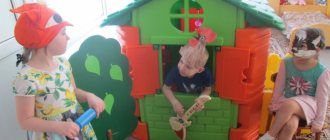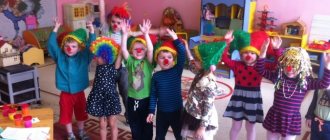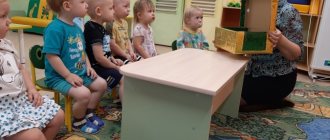Fairy tales for dramatization in the middle group
Children of this age group are characterized by their desire for socialization. They are more actively involved in role-playing games, trying on various roles (social and heroes of famous fairy tales).
Note! In middle preschool age, children become more attentive; they can already perceive not only poetic works, but also short Russian folk works.
What performances can be shown in the middle group?
"Zayushkina's hut"
The role of the leader is the teacher himself or, if desired, the child. The main characters of this tale are:
The teacher must prepare the appropriate props in advance. These are masks with animal ears (bear cub, dog and other heroes) or their image. This is also the bast zayushkina and the ice fox hut. Before the start of the production, the teacher reads a fairy tale to the children, introducing them not only to its content, but also to how to convey the character of the characters using facial expressions and intonation.
The teacher explains to the children the meaning of outdated and unfamiliar words so that the students understand the content of the work. During the discussion of the fairy tale, he asks leading questions about the characters' personalities so that they can convey them during the dramatization. For example, the fox is cunning, the hare is kind, modest, the rooster is brave, and so on for all the characters.
The fairy tale “Zayushkina’s Hut” is associated with the lexical themes “Seasons”, “Domestic and wild animals”. During the dramatization, children learn to form possessive adjectives: hare, bunny's hut, fox.
"Kolobok"
Another popular fairy tale that is in the middle school card index. The leader is an adult or a child. Fairy tale heroes:
The peculiarity of this fairy tale is that the characters have few words, so children need to use more facial expressions and gestures to convey the characters of their characters. The teacher can make a path with plants, mushrooms, and berries along which Kolobok will roll.
This tale is related to the lexical themes “Wild and Domestic Animals”, “Family”. You can also discuss rules of behavior with students.
Note! This work can also be chosen for an improvisation game. For example, invite children to come up with lines for Grandmother and Grandfather. Or other animals from which Kolobok rolled away.
Theatrical activities in kindergarten
"Fly Tsokotukha"
This work is popular with children and is often chosen to be staged because it is in the form of a poem. The characters' phrases are easier to remember, which is why this Russian fairy tale is often chosen for classes in the middle group. The role of the presenter can be divided into several children, because the text is large, or you can choose an excerpt for dramatization.
The whole group can be involved in the staging of “Flies-Tsokotukha”. Children need to portray characters without words using facial expressions, gestures, and movements. The main roles are Mukha-Tsokotukha and Komarik.
This work is also suitable for an improvised script if the level of speech development of children allows them to independently come up with phrases for their characters. This tale can also be used for a logori lesson.
To stage this fairy tale, you should try to prepare a house in which the heroes will live. The teacher can do this independently or approach the children with this request. This will make the children even more willing to take part in theatrical activities.
Children play the roles of a Mouse, a Frog, a Bunny, a Fox, a Wolf Cub and a Bear. When dramatizing, children can add onomatopoeic complexes to words to make the characters’ speech even more expressive.
Note! “Teremok” is best suited for practicing the prosodic side of speech, namely the pitch and strength of the voice.
"Turnip"
This fairy tale is also introduced to children in middle preschool age. You can choose a child or use props in the role of Turnip. The main characters are Grandmother, Grandfather, Granddaughter, Bug (dog), Cat and Mouse.
The peculiarity of this tale is that the characters have practically no words. Therefore, children can improvise. For example, a child playing the “cat” role can say “Meow,” Bug can bark, and Mouse can squeak. For human characters, the teacher asks the children to come up with short phrases.
Important! This fairy tale is also suitable for working with non-speaking children, because onomatopoeia is one of the main directions in working with this category of people. Only in this case there is no need to invite children to come up with phrases on their own.
All of the listed works are suitable for working with children of middle preschool age because they are small in volume; characters speak in simple phrases, their character must be conveyed through facial expressions and gestures. The lexical topics covered are appropriate for the children's age, so they will be able to understand what the fairy tale was about.
After reading, the teacher conducts a brief analysis of the work with the children. He asks questions about what the plot was about, which of the characters is positive and which is negative, why they think so, and other similar questions. Children understand the characters better and will be able to convey them better.
During such a conversation, children learn to express their opinions, which has a positive effect on the quality of coherent speech. The vocabulary is enriched and clarified, sentences become more grammatically correct.
Children dramatize the fairy tale "Teremok"
Tips for implementing theatrical games
To conduct the lesson, it is necessary to draw up a note in which all goals and objectives will be written in accordance with the requirements of the Federal State Educational Standard. A number of conditions must also be met for the implementation of theatrical activities:
Children not only like to listen to fairy tales, but also to feel like they are in the shoes of the characters. Of course, not everyone wants to take on the role of negative characters. Therefore, the teacher must explain to the child why playing a wolf or a fox is just as interesting as playing good heroes. Theatrical games are an opportunity not only to correct speech development, but also to make a child sociable and introduce him to the world of theater.
Source
Progress of the game:
Educator: “Guys, today we are visiting a Russian folk tale. Which? Or maybe you can tell me yourself which one?”
Children, together with the teacher, examine the attributes and try on masks.
Educator: “Guys, have you guessed what fairy tale came to visit us?”
The children answer in unison.
Educator: “Guys, let’s play this fairy tale? Let's first decide where our houses will be?
Presenter: “Once upon a time there was a fox and a hare. The fox had an ice hut, and the bunny had a bast hut (using facial expressions, he shows the bunny his house, and also the fox)
.
Spring has come, the fox's hut has melted, but the bunny's hut remains as before (Cleans the fox's house)
.
Fox: “Bunny, let me warm up”
.
The child, through speech and facial expressions, tries to show how cunning the fox is. On the contrary, the child shows the bunny to be kind.
Presenter: “The fox went to the bunny’s house and kicked him out. A bunny walks along the road and cries, and when he meets him... What do you guys think, who did the bunny meet?”
The children answer in unison: dogs.
Dogs: “Tyaf - tyaf - tyaf! Bunny, why are you crying"
?
The bunny tells them: “My hut was made of bast, but the fox’s was made of ice. In the spring, the fox’s house melted, and she asked me to warm up and drove me out.”
Dogs: “Don’t cry, bunny, we’ll kick her out”
The importance of dramatization in preschool education
Speech development is an important component that influences the harmonious development of personality. Correct speech is not only the basis for successful literacy acquisition, but also socialization in society. And the theatricalization of fairy tales in the middle group is an effective way of forming it.
For preschool children, the leading type of activity is play. Therefore, all the knowledge they gain during the game is absorbed more effectively. Children do not need to be forced to study: they themselves will be happy to participate in such an educational process. Dramatization has a positive effect on:
Important! Dramatizing a fairy tale in the middle group helps to develop a “linguistic sense.” During the production and performance, children can improvise and use proverbs and sayings in coherent speech. All this contributes to the further successful mastery of the linguistic norms of the native language.
Staging children's fairy tales has a positive effect on the emotional and volitional sphere. Children become less inhibited, cease to be afraid of public speaking, and make contact more easily. Dramatization teaches children to better understand the emotions of people around them. This is especially important for those who have speech impairments because they find it difficult to understand the emotional state of other people.
Card index of dramatization games
Adela Shagiakhmetova
Card index of dramatization games
The simplest (for ease of perception)
a conditional classification of games might look like this:
Their rules dictate the need to be able to act simultaneously, equally and in concert with other participants. Games of this type are indispensable for the little ones, because:
– are the first experience of obeying general rules and simple tasks;
– contribute to the development of ideas through characteristic, imitative movements based on supporting visual impressions (show, picture , slide, etc.)
;
– help to gain experience in joint actions, develop trust between children and adults;
– teach coordination of actions in a group;
– develop a sense of rhythm, musicality, motor skills, etc.
In the games of children of middle and senior preschool age, “repeat”
are rarely found in their pure form;
in the “wreath of games”
they can be adequate to
“semantic connections”
.
2. Games for attention
The rules of such games may be associated with the ability to accurately perform game actions at the right moment, without getting lost.
Such rules contribute to the development of targeted auditory perception (for example, in the game “Rain”
According to the corresponding song, hide under
the “roof”
, in the game
“Chicks and the Kite”
- squeak after the words
“The Kite is flying!”
, as well as developing the ability to clearly perform simple game tasks.
The game rule is associated with the need to catch up with someone, to be able to escape from the “driver”
. These are the favorite games of children of middle and senior preschool age. They contribute to:
– formation of initiative and determination;
– development of dexterity, orientation in space, ability to obey rules;
– overcoming fears (when meeting in game circumstances with a “scary”
character: Wolf, Kite, Bear, etc.).
The rules of such games are associated with various tasks: correctly determine the location of a hidden object, guess its name; guess by the nature of the movements the essence of what is happening (for example, profession)
and so on.
With the help of guessing games, targeted visual attention, intelligence and many other qualities are developed.
According to their rules, it is necessary to complete the game action as quickly as possible. Games with a similar concept develop determination, initiative, dexterity, dexterity, spatial orientation, will, etc. As a rule, they involve division into teams and, therefore, form a “sense of community”
, collective responsibility.
Summary of the game-dramatization of a Russian folk tale
"Zayushkina's hut"
in the middle group
The game is a dramatization based on the Russian folk tale “Zayushkina’s Hut”
.
Goal: enrich the gaming experience.
Objectives: Educational: to teach children to distinguish and convey intonations, the characters of fairy-tale characters, to develop children’s ability to create a play environment.
Developmental: to develop in children the expressiveness of intonation, facial expressions, and movements.
Educational: to cultivate friendly relationships in the game, a sense of compassion, mutual assistance.
Characters: fox, hare, dogs, bear, bull, rooster.
Preparing for the game: reading a fairy tale, looking at illustrations, talking, watching a cartoon.
Material: blue and brown material for houses, screen, headdresses - masks, apron for foxes, tail; for a bunny shirt, tail; for the rooster tail, boots, braid.
Vocabulary work: bast, artist, spectator, theater.
How to dramatize fairy tales in secondary groups of preschool educational institutions
Dramatization is one of the important areas of work in kindergarten. This type of activity not only develops communication skills, but also has a beneficial effect on the overall development of boys and girls. They begin their acquaintance with the world of theater with finger puppets, when an adult shows skits, and then children act them out on their own. Starting from the middle group, the teacher dramatizes folk tales with the participation of several kindergarten students.






